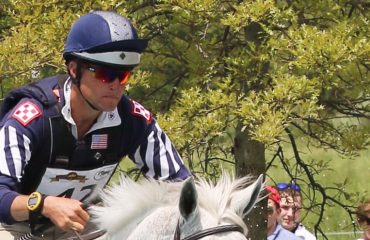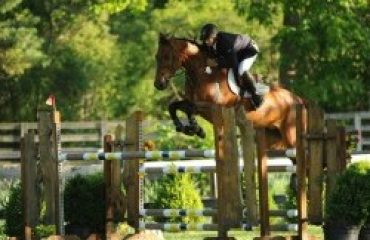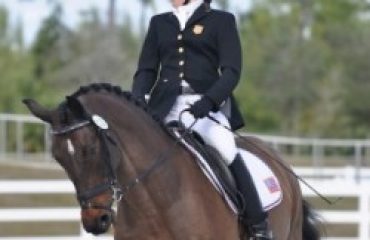How do I bring my horse back from a tendon injury in the right hind? He’s a showmanship horse, so he needs to pivot on the right hind — Cheyenne D. via Facebook
One of the most heartbreaking injuries in the sport of three-day eventing is a bowed tendon. It’s a crushing feeling, waking up the morning after a big event or a gallop, and the tendon down the back of the leg has a profile. I’ve experienced this heart-sinking feeling over and over again and unfortunately now have lots of experience bringing horses back from tendon injuries.
On the bright side, out of all the injuries a horse might pick up, I’ve had the most luck with horses returning to full capacity after a tendon injury; only a couple came back to haunt us, and those were due to me bringing the horses back into work too early.
Obviously I’m not a vet, but the number one thing I’ve learned from great horsemen and -women is you can’t fast-track a tendon. Sure, laser therapy, PRP, shockwave, stem cell and therapeutic ultrasound are all therapies that can assist the healing, but in my experience it doesn’t speed up the time of recovery — it will look better on an ultrasound, but won’t necessarily make the tendon stronger faster.
Step one, after you’ve come to terms with the injury, is to keep them on stall rest for two or three months. I’d do a stable bandage at night, but that’s all. This is an agonizing process when your horse is fit and has been in work and loves doing his job, but he has to stand still and stop using that tendon! I hand graze three times a day for about half an hour each time. It’s good to get the horse out in sunlight and eating some green grass. I’ll caution that the horse may be excitable — this isn’t the time to check your Instagram or listen to music. I’ve had many horses buck and break loose and even injure the handler.
After a month or so I’d build a little round pen out of gates, or use an existing round pen on your farm if you have one, basically as a mini-paddock so the horse can move around a little but can’t pick up a full gallop. I’d probably do this for another six weeks so the horse has a little freedom but can’t re-injure himself.
After four or five months, I put the horse out in a big field. A lot of people will tell you that you can bring them back into work earlier, but every time I’ve done that they’ve been re-injured. I’d start walking with a rider on after about 11 months. That’s three months of stall rest, then the mini-paddock and then another five months in the field. After that I’d have a rider hacking for about 45 minutes a day, which puts a little weight on the horse’s back and gets his back and that tendon used to carrying the weight of a rider.
Around 12 months, I’d walk for 40 minutes and trot for one minute; the next day I’d walk for 40 and trot for two, and then add a minute of trotting each day, so after twenty days you’re walking 40 minutes and trotting 20. After that, I’d jog 20 minutes, then intersperse light flat work. As time goes on, you can do a little more. To begin with, it might just be a couple of circles. After about a month you’ll be back to your regular dressage training and your horse’s tendon should be good to go.
I have a big Thoroughbred mare who is super straight and forward, but not great at turning in between fences. Do you have any exercises to help her? — Hilary P. via Facebook
This is not an uncommon thing. To start with, you can include a lot of 10-meter circles in your flatwork. I’d put a 10-meter circle in every corner of the ring. It’s quite an effort for your big horse to make a tight turn like that, but the more she does it the better she understands that this is part of life and she should learn to bend her body from head to tail.
Next I’d include cavaletti: Go over a small cavaletti on a 15-meter, at a canter, so the horse is always turning. Then start doing figure-eights over the cavaletti on a 15 or 20 meter circle. The horse might trip a bit over a cavaletti, but it’s small and will not cause a loss of confidence like a big jump. Next, instead of a jumping day I call it a jumping-flatwork day: Have a bunch of cavaletti in the ring and just make use of all of them so that you’re constantly turning and jumping and the horse is soft, supple and available, turning before and after the jumps.
Obviously you always want your horse to jump straight, but you can use a small cross pole and let your horse know that it needs to land into a turn both ways, again on a figure-eight. Repetition is key here, asking the horse to be available to turn left and right. There’s no quick fix to this; all horses have a weakness and rideability on the turns is a common problem. I believe the secret is to focus on the flat work and start every jumping session with some sort of rideability exercise over cavalettti.
Photo
Boyd, who recently competed at the Land Rover Kentucky Three-Day Event and will be part of the U.S. Eventing Olympic team in Tokyo, explains the process of bringing a horse back from a tendon injury as well as how to turn between fences.
Photo by Ruby Tevis












